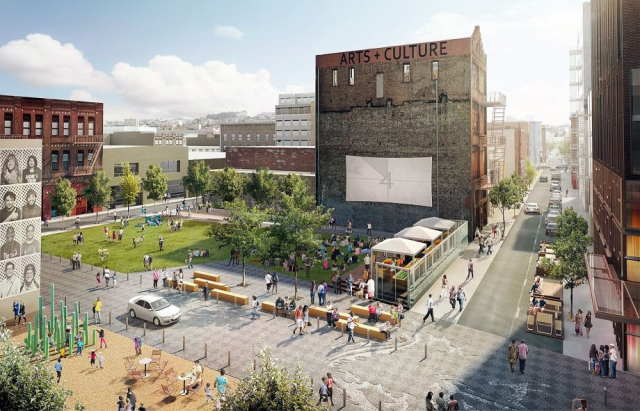Let’s take a look at the numbers — which show that even 33 percent on a big commercial project doesn’t mitigate the damage

By Tim Redmond
JUNE 17, 2015 – Now that Sup. Jane Kim has forced the Giants to accept a significant increase in the amount of affordable housing the team will provide at its Mission Rock development, the message is getting out: The level of below-market-rate housing the city currently requires is nowhere near enough.
So let’s take a look at the redesigned project for the buildings owned by Hearst Corporation at Fifth and Mission. According to the Chron’s J.K. Dineen, the developers
are beefing up their affordable housing and open space commitments in an effort to win approval in a political environment that is becoming increasingly demanding around issues of affordable housing.
First: that’s good news. The housing advocates – and yes, the advocates on the streets are driving this – have changed the political climate so that the typical 15 percent or so set-asides are not going to work anymore.
But it’s important in all of these proposals to put the amount of affordable housing in context. Commercial development creates a demand for housing; everyone agrees on that. In fact, market-rate housing creates a demand for housing.
The city wouldn’t be in the housing crisis it faces today if developers hadn’t been allowed to create millions of new square feet of office space (some of it without paying fees) that attracted thousands of new workers. (Peninsula cities share the blame; in fact, they allow office space and build no housing at all.)
Developers who just build office space are supposed to pay a fee to the city; right now it’s $24.03 a square foot. That’s based on a study that was done back in 1997 that analyzed how many new employees every square foot of space attracted.
Back then, office layouts gave most employees more space than they do today; the tech world likes open floor plans, which among other things tend to crowd in more people (fewer private officers, fewer cubicles).
So the number we use today is almost certainly too low, and the $24.03 doesn’t begin to cover the actual impact. For example, the Fifth and Mission project includes a 614,000 square foot office building. Based on the 1997 (conservative) study, that would generate a need for 307 affordable housing units.
The impact fee will total $14.01 million. Not even close, not nearly even close, to what’s needed to build that much housing. Not even enough to build 10 percent of the needed housing.
So the project starts with a huge housing deficit. Let’s do some math (sorry, but there’s a lot of math involved in this stuff) and see if the 33 percent affordable housing that the developer is promising will meet the city’s needs.
According to the Chron, the developer will build an 83-unit BMR senior complex, and contribute enough to pay for 71 units of a 103-unit project planned for the Tenderloin.
Then 58 of the 288 rental units in one housing complex would be sold below market rate, while another project will include 400 high-end condos.
Total, if I have my math right: 212 BMR units.
Now let’s look at the demand side of the equation. The office building alone will generate the need for 317 affordable units (.000517 units per square foot). The 400 luxury condos will create a demand of between 100 and 160 BMR units, based on the city’s own studies. Then add at least 58 more for the 238 high-end rentals.
Total demand for affordable housing created by this project: at least 475 units.
So for all the talk of adding affordable housing, this project will leave the city with a deficit of at least 263 units.
It will, in other words, cause more problems for the city’s housing crisis than it will solve.
We don’t know the exact figures for how much office space the Giants project will include, so it’s impossible to do the precise figures and see if the 40 percent affordability will be enough. My guess: No.
Bottom line: As long as we keep building market-rate housing and commercial office space at the rate we are approving it, the housing crisis is going to keep getting worse.
Now: At some point pretty soon, maybe as early as this fall, the city will hit the Prop. M limit. That 1986 ballot measure set an annual limit of 850,000 square feet of office space. The amount accumulates if it’s not used, and there was so little construction of any kind during the recessions of the early 1990s and the recent recession that there was plenty of room to spare under the cap.
But now that’s mostly used up. And the big projects already pushing for entitlements – like the Giants and Fifth and Mission – are going to bust the cap.
The City Planning Commission then has to choose which projects to allow – the so-called “beauty contest,” which typically isn’t based on beauty (most of these office towers are hideous) but on the level of amenities the developers offer.
City officials might consider, as part of that process, raising the jobs-housing fee to something the reasonably reflects the real impact these developers, who walk away with huge paydays, are having on the rest of us.



